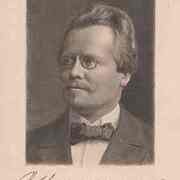Otto Julius Bierbaum (1865–1910)
Auteur de Samalio Pardulus
A propos de l'auteur
Crédit image: Photo © ÖNB/Wien
Séries
Œuvres de Otto Julius Bierbaum
Die Freiersfahrten und Freiersmeinungen des weiberfeindlichen Herrn Pankrazius Graunzer, der Schönen Wissenschaften… 4 exemplaires
Sonderbare Geschichten 3 exemplaires
Der Neubestellte Irrgarten der Liebe: Um Etliche Gaenge und Lauben Vermehrt Verliebte, Launenhafte, Moralische und… (2017) 3 exemplaires
Aus dem Irrgarten der Liebe verliebte, launenhafte, moralische und andere Lieder und Gedichte 3 exemplaires
Gesammelte Werke, sechster Band: Prinz Kuckuck: Leben, Taten, Meinungen und Höllenfahrt eines Wollüstlings (1980) 3 exemplaires
Gugeline. Ein Bühnenspiel in 5 Aufz. von Otto Julius Bierbaum. Mit Buchschmuck v. E. R. Weiss. Als 1.… 2 exemplaires
Der Bräutigam wider Willen : Komödie in 4 Aufzügen. Nach einer Erzählung Dostojewskis 2 exemplaires
Briefe an Gemma 1 exemplaire
Franz Stuck, über hundert Reproductionen nach Gemälden und plastischen Werken, Handzeichnungen und Studien 1 exemplaire
Hans Thoma 1 exemplaire
Ausgewählte Gedichte 1 exemplaire
Zur Kurzweil heitere Geschichten 1 exemplaire
Hamburger Lesehefte : Otto Julius Bierbaum : Zäpfel Kerns Abenteuer : Ein Märchen (1986) — Text — 1 exemplaire
Die drolligen Geschichten des Herrn Balzac 1 exemplaire
Annemargreth und die drei Junggesellen. Eine Raubrittergeschichte: Und: Der Messner-Michel. Eine Profanlegende aus… 1 exemplaire
Gesammelte Werke, siebter Band: Reisegeschichten 1 exemplaire
Biographie 1 exemplaire
Das Reimkarussell 1 exemplaire
Das höllische Automobil : Novellen 1 exemplaire
Gesammelte Werke 1 exemplaire
Die Haare der heiligen Fringilla und andere Geschichten. Sechstes und siebentes Tausend. 1 exemplaire
Zwei Münchener Faschingsspiele 1 exemplaire
Maultrommel und Flöte : neue Verse 1 exemplaire
Aus beiden Lagern : Otto Julius Bierbaum ; Betrachtungen, Karakteristiken u. Stimmungen aus d. ersten… 1 exemplaire
Hans Wurst und andere Grotesken 1 exemplaire
Zwei Stilpe-Komödien 1 exemplaire
Das schöne Mädchen von Bao 1 exemplaire
Oeuvres associées
Der Roman der Zwölf : ein literarischer Scherz aus dem Jahre 1909 (1992) — Contributeur — 10 exemplaires
50 seltsame Geschichten — Contributeur — 1 exemplaire
Velhagen und Klasings Almanach 1909 — Contributeur — 1 exemplaire
Étiqueté
Partage des connaissances
- Autres noms
- MÖBIUS, Martin
BIERBAUM, Otto Julius - Date de naissance
- 1865-06-28
- Date de décès
- 1910-02-01
- Sexe
- male
- Nationalité
- Germany
- Lieu de naissance
- Grünberg, Schlesien, Deutsches Reich
- Lieu du décès
- Dresden, Sachsen, Deutschland
- Lieux de résidence
- Dresden, Sachsen, Deutschland
Leipzig, Sachsen, Deutschland
München, Bayern, Deutschland - Professions
- journalist
editor
writer
librettist
Membres
Discussions
Samalio Pardulus à The Chapel of the Abyss (Juillet 2021)
Critiques
Vous aimerez peut-être aussi
Auteurs associés
Statistiques
- Œuvres
- 57
- Aussi par
- 4
- Membres
- 154
- Popularité
- #135,795
- Évaluation
- 3.9
- Critiques
- 2
- ISBN
- 28
- Langues
- 2
- Favoris
- 1




Samalio Pardulus was a painter in medieval Albania. Rather than documenting him from an omniscient third-person narrator as in À rebours or through the medium of his own written journals as in Fantazius Mallare, Bierbaum places two narrative frames between the reader and the character. First, there is a "staid philistine" Italian painter Messer Giacomo, imported to instruct Samalio, whose journals form the purported documentary basis of the story in the form of extensive quotations. Then there is the anonymous archivist who introduces and comments on Giacomo's account. Through the course of the book, this archivist outside of the quotes retreats to invisibility, having left behind only a suitable readerly suspicion regarding Giacomo's perceptiveness.
Samalio himself is ugly, talented, and blasphemous. He is concerned with making objects out of his imaginings, and to the extent that this work tends to horrify his pious teacher, his explanations of it become theological, deprecating a cosmic demiurge and exalting his own "godly pleasure in the grotesque" (14). Beyond his inchoate gnosticism and solipsism, Samalio defines himself with incestuous ambitions for his beautiful sister. These eventuate in a numinous domestic apocalypse. The interrelation of the principal characters--Samalio, his sister Maria Bianca, their father the Count, an unnamed watchman, and Messer Giacomo--eventually becomes so outre that it awoke in me suspicions of allegory.
This first English edition is illustrated with many full-page charcoal drawings by Alfred Kubin that appeared in the original 1911 German edition. Some of these depict Samalio's paintings, but most are scenes from the novel.… (plus d'informations)